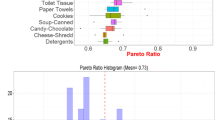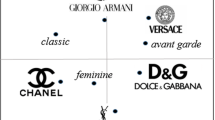Abstract
Market structure has been characterized by the locations of brands in the perceptual space of households (perceptual map) and the importance weights associated with the attributes of this map. It is hypothesized that a line extension or a new brand introduced into this market could potentially affect the brand locations or the importance weights. We show how a simple extension of a recent approach to market structure analysis enables us to empirically identify which, if any, of these two aspects of market structure is affected by the line extension or new brand. An empirical application to the detergent product market is provided.
Similar content being viewed by others
References
Carpenter, G., and K.Nakamoto. (1989). “Consumer Preference Formation and Pioneering Advantage”. Journal of Marketing Research 26, 285–298.
Chamberlain, G. (1980). “Analysis of Covariance with Qualitative Data”. Review of Economic Studies 47, 225–238.
Chatterjee, R., and V. Ramaswamy. (1994). “A Simultaneous Approach to Preference Segmentation and Assessment of New Product Trial.” Working paper, University of Michigan.
Chintagunta, P. K. (1994). “Heterogeneous Logit Model Implications for Brand Positioning”. Journal of Marketing Research 31, 304–311.
Chintagunta, P. K. (1995). “Investigating the Impact of a New Brand Introduction Using Household and Store Level Panel Data.” Working paper, Cornell University.
Chintagunta, P. K., and Bo E.Honore. (1996). “Investigating the Effects of Marketing Variables and Unobserved Heterogeneity in a Multinomial Probit Model”. International Journal of Research in Marketing 13, 1–15.
Elrod, T., and M. P.Keane. (1995). “A Factor-Analytic Probit Model for Market Structure Analysis”. Journal of Marketing Research 32, 1–20.
Fader, P., and B. Hardie. (1996). “Modeling Consumer Choice Among SKUs.” Working paper, The Wharton School, University of Pennsylvania.
Grover, R., and V.Srinivasan. (1992). “Reflections on ‘A Simultaneous Approach to Market Segmentation and Market Structuring.’” Journal of Marketing Research 29, 474–476.
Kahnemann, D., and J.Snell. (1988). “Predicting Utility.” In Robin, Hogarth (ed.), Insights in Decision Making. Chicago: University of Chicago.
Kotler, P. (1994). Marketing Management. New York: Prentice-Hall.
McFadden, Daniel. (1976). “Quantal Choice Analysis: A Survey.” Annals of Economic and Social Measurement 5(4), 363–390.
Moorthy, Sridhar, and P.Papatla. (1996). “Is There a Presence Effect from Line Extensions?” Working paper, University of Wisconsin, Milwaukee.
Stigler, G. J., and Becker, G. S. (1977). “De Gustibus Non Est Disputandem.” American Economic Review 67, 76–90.
Author information
Authors and Affiliations
Rights and permissions
About this article
Cite this article
Chintagunta, P.K. Investigating the effects of a line extension or new brand introduction on market structure. Market Lett 7, 319–328 (1996). https://doi.org/10.1007/BF00435539
Issue Date:
DOI: https://doi.org/10.1007/BF00435539




